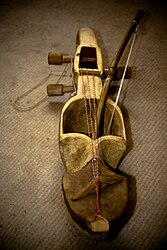 Sarangi is a 4-string bowed lute | |
| String instrument | |
|---|---|
| Other names | Sarangi |
| Classification | Chordophone |
| Hornbostel–Sachs classification | 321.321[1] (chordophone--necked bowl lute: the handle is attached to or carved from the resonator, like a neck) |
| Inventor(s) | Gandarbha people |
| Related instruments | |
| Sarangi | |
| Musicians | |
| Jhalak Man Gandarbha | |
| Sound sample | |
|
| |
The Nepali Sarangi (Nepali: नेपाली सारङ्गी) is a Nepali folk instrument. It is a chordophone played by bowing. Traditionally in Nepal, the Sarangi was only played by people of Gandarbha or Gaine caste (both contested and interchangeable terms), who sing narrative tales and folk song, however, in present days, its popularity extends beyond the Gandharba community and is widely used and played by other caste members as well. It has also garnered much interest in other music genres, such as Nepali rock and film music.[2][3] While the Sarangi has become the quintessential Gandharba instrument, its counterpart, the arbajo,[4][5] which is a plucked lute, has fallen into obscurity.
- ^ "Gaine sarangi".
- ^ Burbank, Jon; Elias, Josie (2014). Nepal (3rd ed.). New York, NY: Cavendish Square. pp. 93–94. ISBN 978-0-7614-8013-6. OCLC 772120571.
- ^ Hutt, Michael; Onta, Pratyoush (2017). Political Change And Public Culture In Post-1990 Nepal. Cambridge University Press. p. 158. ISBN 9781316996287.
- ^ James McConnachie; Rough Guides (Firm) (2000). World music: the rough guide. Rough Guides. pp. 198–. ISBN 978-1-85828-636-5. Retrieved 24 March 2012.
- ^ Alison Arnold (2000). South Asia: the Indian subcontinent. Taylor & Francis. pp. 698–. ISBN 978-0-8240-4946-1. Retrieved 24 March 2012.. ... one of the most important of these rites is puja 'worship' performed to music of the sararigi and the arbajo, believed to be its predecessor.